Theme Parks & Themed Entertainment
WDW’s new “The Muppets Present … Great Moments in American History” show brings authentic Muppet mayhem to Liberty Square
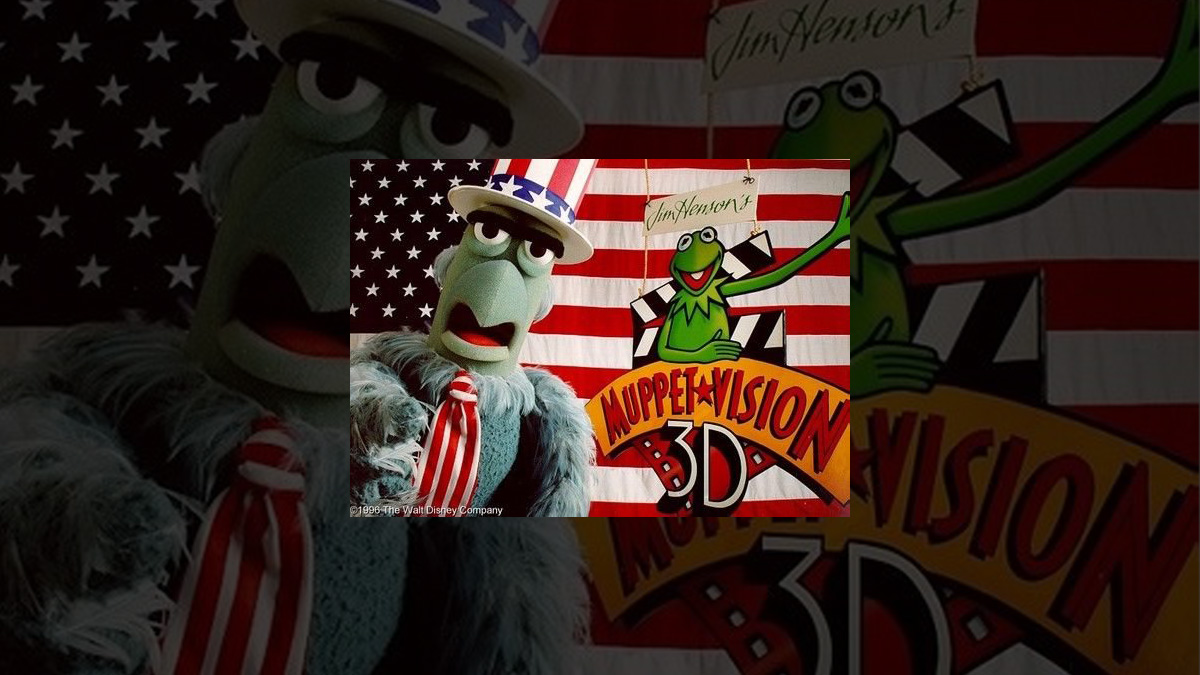
Anyone who’s ever seen “Jim Henson’s Muppet*Vision 3D” can tell you the title of that elaborate pageant which Sam Eagle has put together to close out that show. It’s called “A Salute to All Nations, But Mostly America.”
Sadly, things don’t quite go as this self-proclaimed super-patriot had planned. As “Muppet*Vision 3D” predictably descents into chaos, Kermit the Frog asks Sam if that part of the show is now ready to go.
“It’s a glorious three-hour finale,” this American Eagle enthuses.
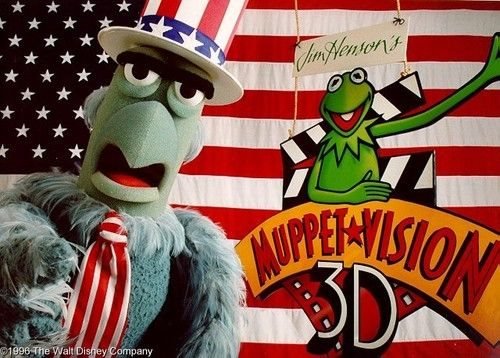 Copyright Disney Enterprises, Inc. All rights reserved
Copyright Disney Enterprises, Inc. All rights reserved
“You got a minute and a half!” Kermit responds.
And so, Sam is forced to present an extremely abbreviated version of his “Salute to All Nations, But Mostly America.” That is the way things have been going ever since “Jim Henson’s Muppet*Vision 3D” first opened at what-was-then-known-as Disney-MGM Studios Theme Park back in May 1991. For the past 25 years, Sam has never been able to pull off the sort of elaborate patriotic pageant he has always dreamed of staging.
Until now.
Beginning last month, Sam began appearing regularly in the second floor windows of Heritage House in the Liberty Square section of WDW‘s Magic Kingdom, and- on occasion – in the Hall of Presidents cupola. From this patriotic perch, he tries to tell Guests down in the street below the true and inspiring story of Paul Revere’s Ride and the Signing of the Declaration of Independence.
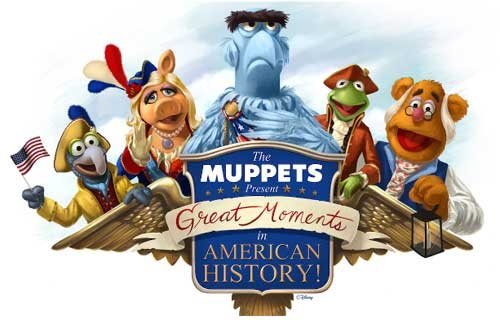 Copyright Disney Enterprises, Inc. All rights reserved
Copyright Disney Enterprises, Inc. All rights reserved
“That was the original concept for this show,” Tara Anderson, the co-director of “The Muppets Present … Great Moments in American History” explained. “That Sam Eagle would interact with Guests all by himself. But then we thought: Wouldn’t be it far more entertaining if Kermit the Frog, Miss Piggy, Fozzie Bear and The Great Gonzo were to suddenly kind of horn in on Sam’s patriotic presentation? So that these much-beloved characters could then present a live show about American history that – as we like to say – the Muppets get it partly right but mostly wrong.”
“What’s great about building this show around stories that most of your audience – really all of your audience – already recognizes in some way, shape or form is that this then provides us with a great palette or platform to build comedy on. Create these fractured moments of character-driven comedy by retelling these well-known historic tales in a somewhat hysterical fashion,” said James Silson, the other co-director of “The Muppets Present … Great Moments in American History.”
WDW Creative Entertainment began developing this project began back in the Spring of 2014, right after “Muppets Most Wanted” had been released to theaters. But because the primary performance venue for this new live-for-the-theme-parks show was supposed to be the second story windows of Liberty Square’s Heritage House … Well, that then meant the “Great Moments in American History” team faced problems that few producers have ever faced.
 Photo by Matt Stroshane. Copyright Disney Enterprises, Inc. All rights reserved
Photo by Matt Stroshane. Copyright Disney Enterprises, Inc. All rights reserved
Take – for example – those majestic trees in this corner of the Magic Kingdom that really make Liberty Square look like a snapshot of Colonial America. Because there were some branches on these now-45 year-old trees that blocked Guests’ views of Heritage House’s second story windows, Walt Disney World’s Creative Entertainment department had to call in Horticulture. With almost surgical precision, they approached the trees in question and determined which specific branches had to be cut back and/or be removed entirely.
Even the Muppets themselves needed some special treatment before making their debut at Liberty Square. Muppets, after all, have always been built to be seen on a television or movie screen – not from the perspective of an audience standing in the street below looking up at a show presented in Heritage House’s second story windows.
WDW’s Creative Entertainment had to make some tweaks to the Muppets themselves to make sure that the characters looked the way they normally do. The puppets used in “The Muppets Present … Great Moments in American History” are actually 5% bigger than the ones used in TV and movie productions.
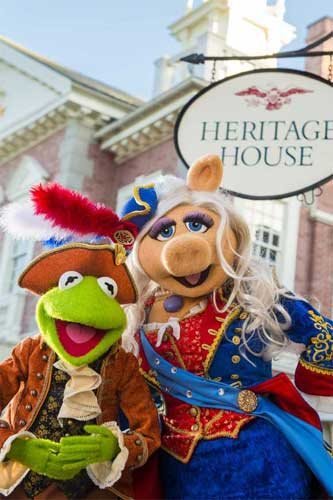 Copyright Disney Enterprises, Inc. All rights reserved
Copyright Disney Enterprises, Inc. All rights reserved
“The talented people who build the Muppets for our television and movie productions also created these puppets,” explained Debbie McClellan, the vice president of The Muppets Studio “We worked very hard make certain the characters you see at Liberty Square are exactly like the characters you know and love on the screen.”
Now that these characters looked right in their new performance venue, it was time for Creative Entertainment to make sure that the two scripts that they had developed for “Great Moments in American History” sounded authentically Muppet as well.
“That’s why we suggested that Jim Lewis be brought into consult. Jim has been writing for the Muppets for over 30 years now, and as he often says, they kind of live inside his head,” McClellan continued. “What Jim wound up doing was fine-tuning the scripts Disney World’s Creative Entertainment department had developed for these shows. He would point out a punchline that would work better for Fozzie, or come up with a bit of comedy business that spotlighted the peculiar talents of Gonzo or Miss Piggy. And of course, as anyone who’s watched the Muppets knows, you can almost always make a scene funnier by throwing in a few chickens. Our goal was to present real history, but with lots of surprises and inspired Muppet silliness.”
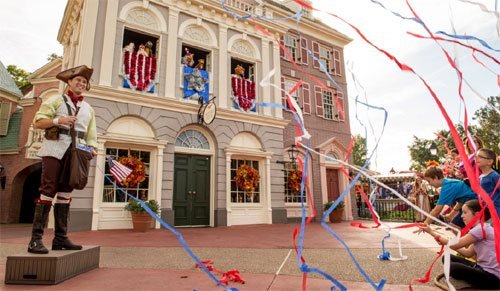 Photo by Matt Stroshane. Copyright Disney Enterprises, Inc. All rights reserved
Photo by Matt Stroshane. Copyright Disney Enterprises, Inc. All rights reserved
Now what’s especially intriguing about “The Muppets Present … Great Moments in American History” is that Creative Entertainment opted to take a different approach with each of these Liberty Square shows.
“And that was a deliberate choice on our part because we wanted to give our guests different experiences,” Anderson stated. “So the Declaration of Independence show – the one that involves James Jefferson, the town crier of Liberty Square – that the “Muppets Present” show features a lot more audience participation. People get to shout out the responses that JJ calls for. And – at the end of that show – there’s even a moment where a child from the crowd gets selected to ring a bell.”
“Whereas with Paul Revere’s Ride, we just wanted a show where the Muppets could do their thing for the guests. Which – in Miss Piggy’s case – meant that she kept changing her outfit. Which is why we finally had to put our foot down and tell Piggy ‘Only three costume changes per show,’ ” Tara laughed.

And then – because so many of our favorite Muppet memories are tied to music – Walt Disney Creative Entertainment hired Brendan Milburn & Valerie Vigoda to write a brand-new song for this show. Which actually manages to tie “The Muppets Present … Great Moments in American History” directly in with “Jim Henson’s Muppet*Vision 3D” by having Sam sing about how this new Liberty Square show (which – according to this feathered super-patriot – will be ” … wholesome, through and through”) will present ” … Great Moments in History, but only the American Parts.”
The end result is a charming new Magic Kingdom show that’s now regularly filling the streets in Liberty Square. Largely because it then gives WDW guests the chance to see the Muppets live and in person up-close.
“These characters have been part of entertainment for decades now. Our parents were very familiar with the Muppets. My generation grew up watching these characters on TV and at the movies. And now we’re sharing our love of the Muppets with our kids. So there’s this whole range of people who already know these characters but have never had the opportunity to get face-to-face with the Muppets,” Silson concluded. “And what “The Muppets Present … Great Moments in American History’ does is that this show actually gives people that opportunity. When they’re performing up on the second floor of Heritage House, the Muppets are so close to the audience that you feel like you could really reach out and touch them. And that experience – having the Muppets performing live, right there in front of you – that makes everybody feel like a kid again.”
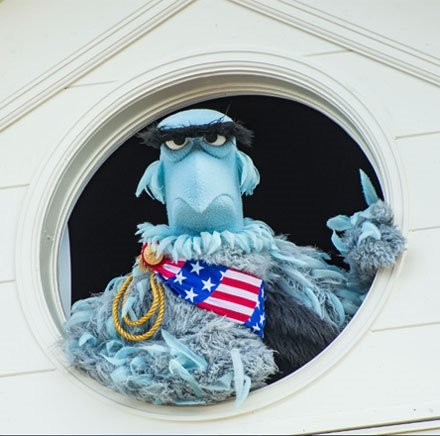 Photo by Matt Stroshane. Copyright Disney Enterprises, Inc. All rights reserved
Photo by Matt Stroshane. Copyright Disney Enterprises, Inc. All rights reserved
Except, perhaps, for Sam Eagle. Who starts out each “The Muppets Present … Great Moments in American History” responding to a line in the show’s theme song which states “… your hair will stand on end from all the history and such” by saying ” … unless – of course – you’re bald like me. In which case … Not so much.”
“This is what we strive for: classic Muppet nonsense – lively, foolish and funny,” McClellan concluded. “Jim Henson used to say: “It’s silly…but it’s worthy of us.” We’re pretty sure Jim would enjoy every minute of this.”
This article was originally published by the Huffington Post on Wednesday, November 9, 2016
History
The Evolution and History of Mickey’s ToonTown

Disneyland in Anaheim, California, holds a special place in the hearts of Disney fans worldwide, I mean heck, it’s where the magic began after all. Over the years it’s become a place that people visit in search of memorable experiences. One fan favorite area of the park is Mickey’s Toontown, a unique land that lets guests step right into the colorful, “Toony” world of Disney animation. With the recent reimagining of the land and the introduction of Micky and Minnies Runaway Railway, have you ever wondered how this land came to be?
There is a fascinating backstory of how Mickey’s Toontown came into existence. It’s a tale of strategic vision, the influence of Disney executives, and a commitment to meeting the needs of Disney’s valued guests.
The Beginning: Mickey’s Birthdayland
The story of Mickey’s Toontown starts with Mickey’s Birthdayland at Walt Disney World’s Magic Kingdom. Opened in 1988 to celebrate Mickey Mouse’s 60th birthday, this temporary attraction was met with such overwhelming popularity that it inspired Disney executives to think bigger. The idea was to create a permanent, immersive land where guests could step into the animated world of Mickey Mouse and his friends.
In the early ’90s, Disneyland was in need of a refresh. Michael Eisner, the visionary leader of The Walt Disney Company at the time, had an audacious idea: create a brand-new land in Disneyland that would celebrate Disney characters in a whole new way. This was the birth of Mickey’s Toontown.
Initially, Disney’s creative minds toyed with various concepts, including the idea of crafting a 100-Acre Woods or a land inspired by the Muppets. However, the turning point came when they considered the success of “Who Framed Roger Rabbit.” This film’s popularity and the desire to capitalize on contemporary trends set the stage for Toontown’s creation.
From Concept to Reality: The Birth of Toontown
In 1993, Mickey’s Toontown opened its gates at Disneyland, marking the first time in Disney Park history where guests could experience a fully realized, three-dimensional world of animation. This new land was not just a collection of attractions but a living, breathing community where Disney characters “lived,” worked, and played.
Building Challenges: Innovative Solutions
The design of Mickey’s Toontown broke new ground in theme park aesthetics. Imagineers were tasked with bringing the two-dimensional world of cartoons into a three-dimensional space. This led to the creation of over 2000 custom-built props and structures that embodied the ‘squash and stretch’ principle of animation, giving Toontown its distinctiveness.
And then there was also the challenge of hiding the Team Disney Anaheim building, which bore a striking resemblance to a giant hotdog. The Imagineers had to think creatively, using balloon tests and imaginative landscaping to seamlessly integrate Toontown into the larger park.

Key Attractions: Bringing Animation to Life
Mickey’s Toontown featured several groundbreaking attractions. “Roger Rabbit’s Car Toon Spin,” inspired by the movie “Who Framed Roger Rabbit,” became a staple of Toontown, offering an innovative ride experience. Gadget’s Go-Coaster, though initially conceived as a Rescue Rangers-themed ride, became a hit with younger visitors, proving that innovative design could create memorable experiences for all ages.
Another crown jewel of Toontown is Mickey’s House, a walkthrough attraction that allowed guests to explore the home of Mickey Mouse himself. This attraction was more than just a house; it was a carefully crafted piece of Disney lore. The house was designed in the American Craftsman style, reflecting the era when Mickey would have theoretically purchased his first home in Hollywood. The attention to detail was meticulous, with over 2000 hand-crafted, custom-built props, ensuring that every corner of the house was brimming with character and charm. Interestingly, the design of Mickey’s House was inspired by a real home in Wichita Falls, making it a unique blend of real-world inspiration and Disney magic.
Mickey’s House also showcased Disney’s commitment to creating interactive and engaging experiences. Guests could make themselves at home, sitting in Mickey’s chair, listening to the radio, and exploring the many mementos and references to Mickey’s animated adventures throughout the years. This approach to attraction design – where storytelling and interactivity merged seamlessly – was a defining characteristic of ToonTown’s success.

Executive Decisions: Shaping ToonTown’s Unique Attractions
The development of Mickey’s Toontown wasn’t just about creative imagination; it was significantly influenced by strategic decisions from Disney executives. One notable input came from Jeffrey Katzenberg, who suggested incorporating a Rescue Rangers-themed ride. This idea was a reflection of the broader Disney strategy to integrate popular contemporary characters and themes into the park, ensuring that the attractions remained relevant and engaging for visitors.
In addition to Katzenberg’s influence, Frank Wells, the then-President of The Walt Disney Company, played a key role in the strategic launch of Toontown’s attractions. His decision to delay the opening of “Roger Rabbit’s Car Toon Spin” until a year after Toontown’s debut was a calculated move. It was designed to maintain public interest in the park by offering new experiences over time, thereby giving guests more reasons to return to Disneyland.
These executive decisions highlight the careful planning and foresight that went into making Toontown a dynamic and continuously appealing part of Disneyland. By integrating current trends and strategically planning the rollout of attractions, Disney executives ensured that Toontown would not only capture the hearts of visitors upon its opening but would continue to draw them back for new experiences in the years to follow.
Global Influence: Toontown’s Worldwide Appeal
The concept of Mickey’s Toontown resonated so strongly that it was replicated at Tokyo Disneyland and influenced elements in Disneyland Paris and Hong Kong Disneyland. Each park’s version of Toontown maintained the core essence of the original while adapting to its cultural and logistical environment.
Evolution and Reimagining: Toontown Today
As we approach the present day, Mickey’s Toontown has recently undergone a significant reimagining to welcome “Mickey & Minnie’s Runaway Railway” in 2023. This refurbishment aimed to enhance the land’s interactivity and appeal to a new generation of Disney fans, all while retaining the charm that has made ToonTown a beloved destination for nearly three decades.

Dive Deeper into ToonTown’s Story
Want to know more about Mickey’s Toontown and hear some fascinating behind-the-scenes stories, then check out the latest episode of Disney Unpacked on Patreon @JimHillMedia. In this episode, the main Imagineer who worked on the Toontown project shares lots of interesting stories and details that you can’t find anywhere else. It’s full of great information and fun facts, so be sure to give it a listen!
History
Unpacking the History of the Pixar Place Hotel

Pixar Place Hotel, the newly unveiled 15-story tower at the Disneyland Resort, has been making waves in the Disney community. With its unique Pixar-themed design, it promises to be a favorite among visitors.
However, before we delve into this exciting addition to the Disneyland Resort, let’s take a look at the fascinating history of this remarkable hotel.
The Emergence of the Disneyland Hotel
To truly appreciate the story of the Pixar Place Hotel, we must turn back the clock to the early days of Disneyland. While Walt Disney had the visionary ideas and funding to create the iconic theme park, he faced a challenge when it came to providing accommodations for the park’s visitors. This is where his friend Jack Wrather enters the picture.
Jack Wrather, a fellow pioneer in the television industry, stepped in to assist Walt Disney in realizing his dream. Thanks to the success of the “Lassie” TV show produced by Wrather’s company, he had the financial means to build a hotel right across from Disneyland.
The result was the Disneyland Hotel, which opened its doors in October 1955. Interestingly, the early incarnation of this hotel had more of a motel feel than a hotel, with two-story buildings reminiscent of the roadside motels popular during the 1950s. The initial Disneyland Hotel consisted of modest structures that catered to visitors looking for affordable lodging close to the park. While the rooms were basic, it marked the beginning of something extraordinary.
The Evolution: From Emerald of Anaheim to Paradise Pier
As Disneyland’s popularity continued to soar, so did the demand for expansion and improved accommodations. In 1962, the addition of an 11-story tower transformed the Disneyland Hotel, marking a significant transition from a motel to a full-fledged hotel.
The addition of the 11-story tower elevated the Disneyland Hotel into a more prominent presence on the Anaheim skyline. At the time, it was the tallest structure in all of Orange County. The hotel’s prime location across from Disneyland made it an ideal choice for visitors. With the introduction of the monorail linking the park and the hotel, accessibility became even more convenient. Unique features like the Japanese-themed reflecting pools added to the hotel’s charm, reflecting a cultural influence that extended beyond Disney’s borders.
Japanese Tourism and Its Impact
During the 1960s and 1970s, Disneyland was attracting visitors from all corners of the world, including Japan. A significant number of Japanese tourists flocked to Anaheim to experience Walt Disney’s creation. To cater to this growing market, it wasn’t just the Disneyland Hotel that aimed to capture the attention of Japanese tourists. The Japanese Village in Buena Park, inspired by a similar attraction in Nara, Japan, was another significant spot.
These attractions sought to provide a taste of Japanese culture and hospitality, showcasing elements like tea ceremonies and beautiful ponds with rare carp and black swans. However, the Japanese Village closed its doors in 1975, likely due to the highly competitive nature of the Southern California tourist market.
The Emergence of the Emerald of Anaheim
With the surge in Japanese tourism, an opportunity arose—the construction of the Emerald of Anaheim, later known as the Disneyland Pacific Hotel. In May 1984, this 15-story hotel opened its doors.
What made the Emerald unique was its ownership. It was built not by The Walt Disney Company or the Oriental Land Company (which operated Tokyo Disneyland) but by the Tokyu Group. This group of Japanese businessmen already had a pair of hotels in Hawaii and saw potential in Anaheim’s proximity to Disneyland. Thus, they decided to embark on this new venture, specifically designed to cater to Japanese tourists looking to experience Southern California.
Financial Challenges and a Changing Landscape
The late 1980s brought about two significant financial crises in Japan—the crash of the NIKKEI stock market and the collapse of the Japanese real estate market. These crises had far-reaching effects, causing Japanese tourists to postpone or cancel their trips to the United States. As a result, reservations at the Emerald of Anaheim dwindled.
To adapt to these challenging times, the Tokyu Group merged the Emerald brand with its Pacific hotel chain, attempting to weather the storm. However, the financial turmoil took its toll on the Emerald, and changes were imminent.
The Transition to the Disneyland Pacific Hotel
In 1995, The Walt Disney Company took a significant step by purchasing the hotel formerly known as the Emerald of Anaheim for $35 million. This acquisition marked a change in the hotel’s fortunes. With Disney now in control, the hotel underwent a name change, becoming the Disneyland Pacific Hotel.
Transformation to Paradise Pier
The next phase of transformation occurred when Disney decided to rebrand the hotel as Paradise Pier Hotel. This decision aligned with Disney’s broader vision for the Disneyland Resort.
While the structural changes were limited, the hotel underwent a significant cosmetic makeover. Its exterior was painted to complement the color scheme of Paradise Pier, and wave-shaped crenellations adorned the rooftop, creating an illusion of seaside charm. This transformation was Disney’s attempt to seamlessly integrate the hotel into the Paradise Pier theme of Disney’s California Adventure Park.
Looking Beyond Paradise Pier: The Shift to Pixar Place
In 2018, Disneyland Resort rebranded Paradise Pier as Pixar Pier, a thematic area dedicated to celebrating the beloved characters and stories from Pixar Animation Studios. As a part of this transition, it became evident that the hotel formally known as the Disneyland Pacific Hotel could no longer maintain its Paradise Pier theme.
With Pixar Pier in full swing and two successful Pixar-themed hotels (Toy Story Hotels in Shanghai Disneyland and Tokyo Disneyland), Disney decided to embark on a new venture—a hotel that would celebrate the vast world of Pixar. The result is Pixar Place Hotel, a 15-story tower that embraces the characters and stories from multiple Pixar movies and shorts. This fully Pixar-themed hotel is a first of its kind in the United States.
The Future of Pixar Place and Disneyland Resort
As we look ahead to the future, the Disneyland Resort continues to evolve. The recent news of a proposed $1.9 billion expansion as part of the Disneyland Forward project indicates that the area surrounding Pixar Place is expected to see further changes. Disneyland’s rich history and innovative spirit continue to shape its destiny.
In conclusion, the history of the Pixar Place Hotel is a testament to the ever-changing landscape of Disneyland Resort. From its humble beginnings as the Disneyland Hotel to its transformation into the fully Pixar-themed Pixar Place Hotel, this establishment has undergone several iterations. As Disneyland Resort continues to grow and adapt, we can only imagine what exciting developments lie ahead for this iconic destination.
If you want to hear more stories about the History of the Pixar Place hotel, check our special edition of Disney Unpacked over on YouTube.
Stay tuned for more updates and developments as we continue to explore the fascinating world of Disney, one story at a time.
History
From Birthday Wishes to Toontown Dreams: How Toontown Came to Be

In the latest release of Episode 4 of Disney Unpacked, Len and I return, joined as always by Disney Imagineering legend, Jim Shull. This two-part episode covers all things Mickey’s Birthday Land and how it ultimately led to the inspiration behind Disneyland’s fan-favorite land, “Toontown”. But let’s not get ahead of ourselves here. It all starts in the early days at Disneyland.
Early Challenges in Meeting Mickey
Picture this: it’s the late 1970s and early 1980s, and you’re at Disneyland. You want to meet the one and only Mickey Mouse, but there’s no clear way to make it happen. You rely on Character Guides, those daily printed sheets that point you in Mickey’s general direction. But let’s be honest, it was like finding a needle in a haystack. Sometimes, you got lucky; other times, not so much.

Mickey’s Birthdayland: A Birthday Wish that Came True
Fast forward to the late 1980s. Disney World faced a big challenge. The Disney-MGM Studios Theme Park was under construction, with the company’s marketing machine in full swing, hyping up the opening of Walt Disney World’s third theme park, MGM Studios, in the Spring of 1989. This extensive marketing meant that many people were opting to postpone their family’s next trip to Walt Disney World until the following year. Walt Disney World needed something compelling to motivate guests to visit Florida in 1988, the year before Disney MGM Studios opened.
Enter stage left, Mickey’s Birthdayland. For the first time ever, an entire land was dedicated to a single character – and not just any character, but the mouse who started it all. Meeting Mickey was no longer a game of chance; it was practically guaranteed.

The Birth of Birthdayland: Creative Brilliance Meets Practicality
In this episode, we dissect the birth of Mickey’s Birthdayland, an initiative that went beyond celebrating a birthday. It was a calculated move, driven by guest feedback and a need to address issues dating back to 1971. Imagineers faced the monumental task of designing an experience that honored Mickey while efficiently managing the crowds. This required the perfect blend of creative flair and logistical prowess – a hallmark of Disney’s approach to theme park design.
Evolution: From Birthdayland to Toontown
The success of Mickey’s Birthdayland was a real game-changer, setting the stage for the birth of Toontown – an entire land that elevated character-centric areas to monumental new heights. Toontown wasn’t merely a spot to meet characters; it was an immersive experience that brought Disney animation to life. In the episode, we explore its innovative designs, playful architecture, and how every nook and cranny tells a story.

Impact on Disney Parks and Guests
Mickey’s Birthdayland and Toontown didn’t just reshape the physical landscape of Disney parks; they transformed the very essence of the guest experience. These lands introduced groundbreaking ways for visitors to connect with their beloved characters, making their Disney vacations even more unforgettable.
Beyond Attractions: A Cultural Influence
But the influence of these lands goes beyond mere attractions. Our episode delves into how Mickey’s Birthdayland and Toontown left an indelible mark on Disney’s culture, reflecting the company’s relentless dedication to innovation and guest satisfaction. It’s a journey into how a single idea can grow into a cherished cornerstone of the Disney Park experience.

Unwrapping the Full Story of Mickey’s Birthdayland
Our two-part episode of Disney Unpacked is available for your viewing pleasure on our Patreon page. And for those seeking a quicker Disney fix, we’ve got a condensed version waiting for you on our YouTube channel. Thank you for being a part of our Disney Unpacked community. Stay tuned for more episodes as we continue to “Unpack” the fascinating world of Disney, one story at a time.
-

 News & Press Releases11 months ago
News & Press Releases11 months agoDisney Will Bring D23: The Ultimate Disney Fan Event to Anaheim, California in August 2024
-

 History6 months ago
History6 months agoFrom Birthday Wishes to Toontown Dreams: How Toontown Came to Be
-

 History6 months ago
History6 months agoUnpacking the History of the Pixar Place Hotel
-

 History6 months ago
History6 months agoThe Evolution and History of Mickey’s ToonTown
-

 News & Press Releases5 months ago
News & Press Releases5 months agoNew Updates and Exclusive Content from Jim Hill Media: Disney, Universal, and More
-

 Film & Movies3 months ago
Film & Movies3 months agoHow Disney’s “Bambi” led to the creation of Smokey Bear
-

 Merchandise4 months ago
Merchandise4 months agoIntroducing “I Want That Too” – The Ultimate Disney Merchandise Podcast






